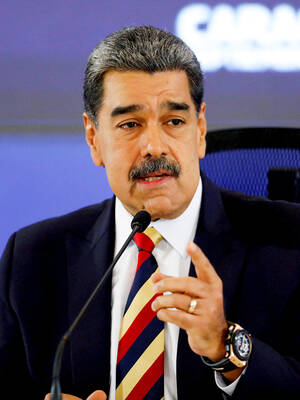Before the earthquake changed everything, 83-year-old Sueko Naka from Japan’s remote Noto Peninsula wished to live out her life at home, watched over by an altar to her ancestors, but a year after a magnitude 7.5 quake and its aftershocks devastated the region, she lives in a small temporary unit with her husband and daughter, facing an uncertain future.
“When I imagine I might die here, I can’t sleep well,” Naka said among her minimal belongings in the newly built dwelling in the city of Wajima.
“I guess I have to accept reality. We have a place to stay,” she said.

Photo: AFP
The earthquake on New Year’s Day last year was Japan’s deadliest in more than a decade, claiming nearly 470 lives.
About half of the victims were killed in the disaster itself, which brought tsunami waves and sparked a huge fire in Wajima’s city center, burning down a historic market.
The rest perished later, as hundreds of aftershocks and cold weather compounded stress for survivors, including 40,000 people — many elderly — evacuated to shelters in school gymnasiums and community centers.
A year later, Ishikawa Prefecture still quivers with aftershocks, stoking fears of another huge jolt. Unprecedented rains in September also unleashed severe flooding in Noto, resulting in 16 further deaths.
Today, more than 200 people still live in shared emergency shelters, while thousands of others like Naka are in accommodation units meant as a stop-gap solution.
Even in the fourth-biggest economy, reconstruction has been slow, with only one-quarter of Wajima’s heavily damaged buildings demolished so far.
The quake ripped up roads and triggered landslides, making it difficult for heavy equipment to traverse the rural peninsula on the Sea of Japan coast.
Its most remote parts give the impression of a large construction site dotted with empty homes, some at slanted angles.
An army of demolition crews operate heavy trucks on pavements warped into wavy, uneven surfaces, but locals say much more is still needed to clear the destruction.
After the earthquake “we received various forms of external support, and there was an emerging sense that everyone was going to start over, but the torrential rain swept away everything, and people had to go back to square one,” Wajima city official Yasuaki Ipponmatsu said. “That was very difficult.”
New Year is an important period of rest for Japanese families, so when the strongest of several quakes hit on the afternoon of Jan. 1 last year, Naka was at home with her husband.
Its force knocked them to the floor as the foundations of their house dropped 50cms.
“A big roar came from the house next door. Their house crashed down on ours, leaning on it,” Naka said. “I thought: ‘This cannot be.’”
The couple’s family home was among the newer structures in their Wajima neighborhood, built after a magnitude 6.9 earthquake in 2007 destroyed their previous house.
“When I remember what happened, I can only cry,” Naka said.
The quake significantly damaged more than 100,000 buildings and completely destroyed another 6,000 across Ishikawa Prefecture.
The disasters and slow recovery have prompted many Noto Peninsula residents to start new lives elsewhere, aggravating an existing depopulation crisis as Japan’s population ages.
About 21,000 people now live in Wajima, 2,500 fewer than last year. A decade ago the city was home to nearly 30,000.
“Would they decide to build new homes and return? I think it will be hard,” said Chugo Maruyama, who helps operate a large evacuation shelter in Suzu, next to Wajima.
“I think our town could be headed straight for extinction,” the 70-year-old said.
The community is exploring ways to encourage young people to stay and rebuild, but the challenges are daunting, with rice fields ruptured and filled with sediment, and ports and irrigation canals damaged.
The disaster has also scattered Naka’s family. She and her husband shared their home with their son-in-law and three grandchildren, but they now live elsewhere.
Their 53-year-old daughter Miyuki Kijima moved back to Wajima to look after the elderly couple.
When she thinks of the repeated disasters the Noto Peninsula has suffered, she asks: “Why only Wajima, why again?”
“We want to repair our home and live there again, but what if it happens again after we repair it?” she said.
For Kijima, the New Year is now “only scary.”
“All I want is for the seven of us to spend our lives together,” she said.

China on Monday announced its first ever sanctions against an individual Japanese lawmaker, targeting China-born Hei Seki for “spreading fallacies” on issues such as Taiwan, Hong Kong and disputed islands, prompting a protest from Tokyo. Beijing has an ongoing spat with Tokyo over islands in the East China Sea claimed by both countries, and considers foreign criticism on sensitive political topics to be acts of interference. Seki, a naturalised Japanese citizen, “spread false information, colluded with Japanese anti-China forces, and wantonly attacked and smeared China”, foreign ministry spokesman Lin Jian told reporters on Monday. “For his own selfish interests, (Seki)

VENEZUELAN ACTION: Marco Rubio said that previous US interdiction efforts have not stemmed the flow of illicit drugs into the US and that ‘blowing them up’ would US President Donald Trump on Wednesday justified a lethal military strike that his administration said was carried out a day earlier against a Venezuelan gang as a necessary effort by the US to send a message to Latin American cartels. Asked why the military did not instead interdict the vessel and capture those on board, Trump said that the operation would cause drug smugglers to think twice about trying to move drugs into the US. “There was massive amounts of drugs coming into our country to kill a lot of people and everybody fully understands that,” Trump said while hosting Polish President

Japan yesterday heralded the coming-of-age of Japanese Prince Hisahito with an elaborate ceremony at the Imperial Palace, where a succession crisis is brewing. The nephew of Japanese Emperor Naruhito, Hisahito received a black silk-and-lacquer crown at the ceremony, which marks the beginning of his royal adult life. “Thank you very much for bestowing the crown today at the coming-of-age ceremony,” Hisahito said. “I will fulfill my duties, being aware of my responsibilities as an adult member of the imperial family.” Although the emperor has a daughter — Princess Aiko — the 23-year-old has been sidelined by the royal family’s male-only

A French couple kept Louise, a playful black panther, in an apartment in northern France, triggering panic when she was spotted roaming nearby rooftops. The pair were were handed suspended jail sentences on Thursday for illegally keeping a wild animal, despite protesting that they saw Louise as their baby. The ruling follows a September 2019 incident when the months-old feline was seen roaming a rooftop in Armentieres after slipping out of the couple’s window. Authorities captured the panther by sedating her with anesthetic darts after she entered a home. No injuries were reported during the animal’s time on the loose. The court in the